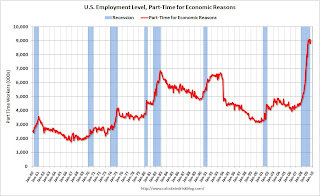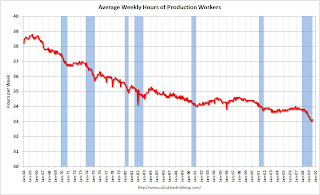by Calculated Risk on 9/04/2009 10:40:00 AM
Friday, September 04, 2009
Employment-Population Ratio, Part Time Workers, Average Workweek
A few more graphs based on the (un)employment report ...
Employment-Population Ratio Click on graph for larger image in new window.
Click on graph for larger image in new window.
This graph show the employment-population ratio; this is the ratio of employed Americans to the adult population.
Note: the graph doesn't start at zero to better show the change.
The general upward trend from the early '60s was mostly due to women entering the workforce. As an example, in 1964 women were about 32% of the workforce, today the percentage is closer to 50%.
This measure fell in August to 59.2%, the lowest level since the early '80s. This also shows the weak recovery following the 2001 recession - and the current cliff diving!
Part Time for Economic Reasons
From the BLS report:
In August, the number of persons working part time for economic reasons was little changed at 9.1 million. These individuals indicated that they were working part time because their hours had been cut back or because they were unable to find a full-time job. The number of such workers rose sharply in the fall and winter but has been little changed since March.
 The number of workers only able to find part time jobs (or have had their hours cut for economic reasons) is at 9.076 million. This is only slightly below the peak of 9.084 million in May.
The number of workers only able to find part time jobs (or have had their hours cut for economic reasons) is at 9.076 million. This is only slightly below the peak of 9.084 million in May.Note: the U.S. population is significantly larger today (about 305 million) than in the early '80s (about 228 million) when the number of part time workers almost reached 7 million. That is the equivalent of about 9.3 million today, so population adjusted this is not quite a record.
Average Weekly Hours
From the BLS report:
In August, the average workweek for production and nonsupervisory workers on private nonfarm payrolls was unchanged at 33.1 hours. The manufacturing workweek and factory overtime also showed no change over the month (at 39.8 hours and 2.9 hours, respectively).
 The average weekly hours has been declining since the early '60s, but usually falls faster during a recession. Average weekly hours worked has essentially been flat since March.
The average weekly hours has been declining since the early '60s, but usually falls faster during a recession. Average weekly hours worked has essentially been flat since March.Some analyst look to an increase in this series as an indicator a recession is over. I guess they are still waiting.
Note: the graph doesn't start at zero to better show the change.
Earlier employment posts today:


